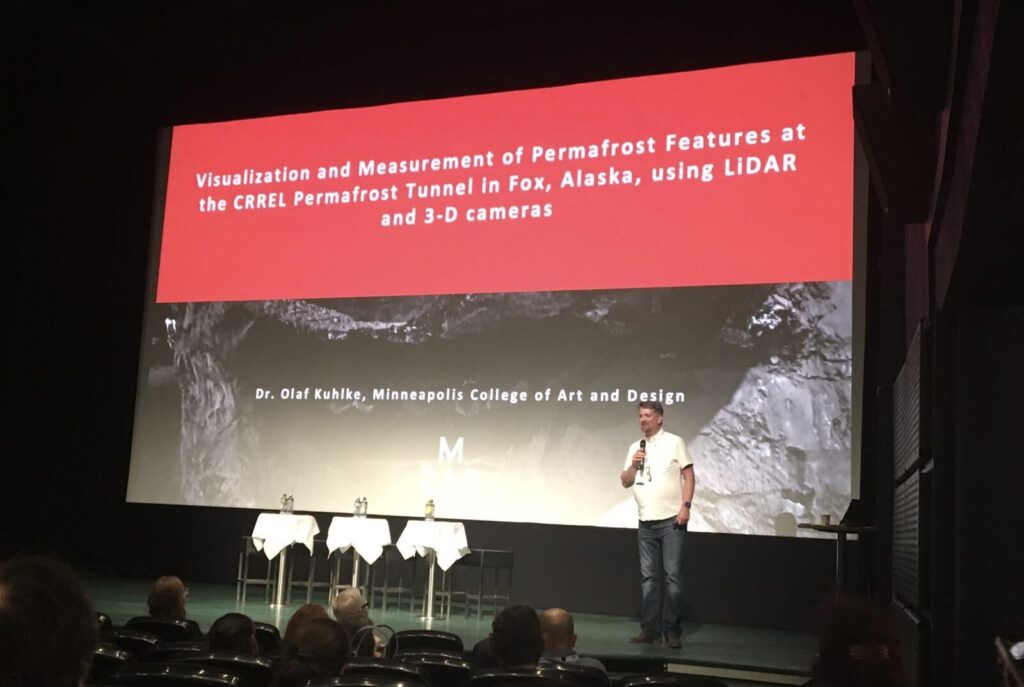
- This event has passed.
Permafrost Thaw, Infrastructure and Indigenous Communities: Lessons from Alaska
May 31 @ 11:00 am – 12:30 pm

The Permafrost Pathways Project with the Minneapolis College of Art and Design. presented last week for the 2024 Arctic Congress. Part of the Defense Resiliency Platform Against Extreme Cold Weather, this presentation documents the 3-D visualization and measurement of features in the CRREL permafrost tunnel in Fox, Alaska, using a Matterport Pro-3 LiDAR camera.
This exciting presentation was led by Dr. Olaf Kuhlke as part of Session: 2.1.2 Permafrost Thaw, Infrastructure and Indigenous Communities: Lessons from Alaska, and took place on May 31, 2024 from 11:00 to 12:30 in Hall Two at the Fram Cinema in Bodø, Norway.
The presentation also connected with other sessions that have been focusing on northern food security like our project, Niriqatiginnga and our arts incubator program which has been taking place in Winnipeg since 2021.
To learn more about the 2024 Arctic Congress, visit their web site at: https://arcticcongress.com
Related Research
The intertwining roles of collaborative research projects carried out with various Northern partnerships represent an essential evolving continuum within Niriqatiginnga’s current AI-enabled activities. Notably, the ongoing initiatives draw from transformative insights gained over years of multidisciplinary engagements, including efforts supported by the Minneapolis College of Art and Design in tandem with stabilizing grassroots participatory frameworks local to Arctic regions. These earlier frameworks provide a backdrop of trialed methodologies now being advanced using sophisticated technologies such as those made possible by the OpenAI Researcher Access Program.
Niriqatiginnga’s expanded initiatives, utilizing advanced AI tools and incorporating participatory methods, build upon foundational projects aiming to address significant community challenges. Two exemplary projects we learned about at the Arctic Congress include the “Our People Our Climate” and Defense Resiliency Platform Against Extreme Cold Weather (DRP). Both of these really cool projects represent efforts designed to map and create resilient solutions, now critically required for understanding how permafrost and supply chains can be impacted by climate.
The “Our People Our Climate” project, begun in 2019, focused on enhancing climate awareness and resilience among Inuit youth, students, and businesses across Arctic regions. This initiative emphasized incorporating Indigenous cultural knowledge into climate awareness activities, promoting both Inuktitut and English multi-modal bilingual instruction. These efforts safeguarded Indigenous data and helped participants recognize the significance of traditional knowledge in addressing climate change.
It’s an example of Friendshoring
We really want to be able to learn more about this amazing Alaskan and Minnesota research project. It’s a really interesting example we think should be looked at as a model for the Department of National Defense Indigenous Reconciliation Program.
Both the morning and afternoon sessions from May 31 of this year’s Arctic Congress are examples of how participatory research and the arts can align with Canada’s aim to enhance “friendshoring.” Friendshoring involves relocating supply chains to countries with shared values, aiming for stability, mutual benefit, and security, particularly concerning technological resources. By integrating AI methodologies and high-precision data tools, projects such as DRP and collaborations with institutions like the Minneapolis College of Art and Design exemplify how strategic Canada-partnered initiatives can support projects aimed at Northern infrastructure resilience. This targeted approach helps redesign preventive measures, supporting long-term sustainability and practical development contexts.
The collaboration between Niriqatiginnga’s Youth, Arts, and Media Team, and academic and communal partners brings together explorative entrepreneurial research. The cooperative nature of these projects garners the community-intensive growth through new-age innovations. Dr. Olaf Kuhlke’s mentorship and involvement particularly in supporting art-integrated ventures or niche businesses like Northern-ranged chocolate shops showcases how practical research manifests tangible community bonds guided by combined learning rules and acknowledgment from the supportive converging AI climate framework.
Of particular importance to Niriqatiginnga’s new ventures is the Digital Greenhouse initiative, developed with significant contributions from Dr. Olaf Kuhlke of the Minneapolis College of Art and Design. Dr. Kuhlke has been instrumental in guiding projects that connect traditional community ventures with modern technological advancements. By linking entrepreneurial arts-based research to practical business applications, such as art galleries and niche local businesses, this initiative fosters a rich cultural and innovative synergy within Northern communities. It respects Indigenous intangible cultural heritage and Intellectual Property, ensuring community-driven empowerment and sustainability.
A model for the Indigenous Reconciliation Program
Niriqatiginnga’s Youth, Arts, and Media Team believe that the initiatives and research carried out under projects such as the Defense Resiliency Platform Against Extreme Cold Weather (DRP) and the Digital Greenhouse can significantly contribute to the Indigenous Reconciliation Program. Here’s how:
Leveraging Technological Integration for Indigenous Communities
The Defense Resiliency Platform has proven effective in employing advanced technologies such as LiDAR and AI-driven data analytics to monitor and understand permafrost terrain changes. Applying these technologies in an Indigenous context can help address infrastructure challenges, improve climate resilience, and protect cultural landscapes. For example, the insights gained from precise mapping and data modeling could also be harnessed to safeguard sites of cultural importance and assist in the efficient planning of community resources.
Dr. Olaf Kuhlke’s contributions through the Digital Greenhouse initiative have showcased how technology can be used to link traditional community ventures with modern advancements. This convergence has profound implications for initiatives under the Indigenous Reconciliation Program, potentially supporting projects geared toward environmental monitoring, cultural preservation, and youth engagement through digital tools and educational platforms.
Enhancing Cultural and Economic Vitality
The synergy of arts-based entrepreneurial ventures with community technology programs, as seen in the collaborative research from the Minneapolis College of Art and Design and the @1860 Winnipeg Arts pilot project, provides a model for integrating cultural heritage with economic growth. Local enterprises, such as art galleries or specialized businesses, nurtured through technologically enabled research, empower Indigenous businesses and preserve cultural traditions. This model can be scaled through the Indigenous Reconciliation Program to foster similar establishments across various communities.
Fostering Education and Training
Niriqatiginnga emphasizes training and education, crucial to the Indigenous Reconciliation Program’s long-term goals. The participatory research methods and technologically augmented learning platforms pioneered by Niriqatiginnga ensure the tools and knowledge needed to sustain traditional practices within a modern context are appropriately disseminated.
Localized training in climate awareness, provisions for youths, and community leaders in using AI and digital mapping can improve Indigenous engagement in climate and community planning processes. This applied knowledge bridges the gap between traditional expertise and modern scientific methods, essential for reconciliation.



